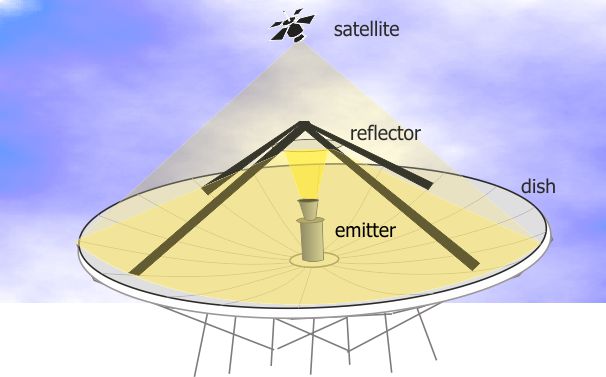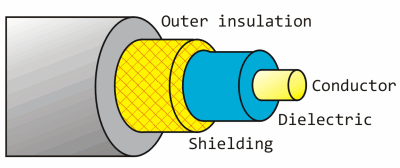Freesat reception - all about dishes
 Brian Butterworth published on UK Free TV
Brian Butterworth published on UK Free TV Satellite reception has both advantages and disadvantages compare with terrestrial (aerial) reception.
By using much higher frequencies (gigahertz, compared to terrestrial televisions megahertz) more transmission channels called transponders (the satellite equivalent of multiplexes) can be provided. For example, there are only six Freeview multiplexes, but Sky or Freesat users can access two hundred satellite transponders.
Aside from exceptional weather conditions (very heavy rain for example) digital satellite provides stable pictures and audio. Where Freeview transmitters are no more than 732 metres above sea level, the geostationary satellites used for television are 35,800,000 metres above the equator so reception is possible even where buildings, trees and hills make terrestrial reception impossible.

The downside of the transmitters being 22,300 miles up in the air is that the signals are very, very weak - so standard TV aerial is of little use. When the signals are sent to the satellites, huge dish transmitters are used to uplink the signal to the satellite. These are tens of metres from side to side, and feature an emitter that generates the signal, which is first bounced of a mirror (called a reflector) and then off the surface of the parabolic dish.

There are many satellites in the sky over the equator. Often these are in clusters over a particular position, for example there are four used for UK television are at 28.2 degrees east. There is another cluster over the 19.2 degrees east positions that are used for German television.
To receive these very weak signals from the satellite, it is necessary to use a dish for reception too. By using a reflective dish, this concentrates the signals onto a small device called a LNB. This is held in front of the dish by a metal arm.

The size of dish for reception is typically much smaller; often 60cm to 100cm in diameter, but the exact size depends upon the transmitting satellite transponder. To keep the transmission power levels down to levels that can be powered by the satellite's solar panels, each beam is focused on a particular area of the Earth's surface. If you are trying to receive the signal at the centre of this zone, a small dish is required. At the outer edges, you may need a 5 metre dish. Maps of these zones are provided by the satellite companies, and are called satellite footprints.
When the dish is installed it must be aligned carefully as the signal is very weak. The installer needs to know the inclination and the azimuth from the ground location to the satellite. If you install yourself you will find that there are markings on the dish that are used to point the dish in the correct position. It is important that the view of the satellite will not be blocked, so must take into account leaves growing on trees and potential building works.
For many people the LNB will have a single cable connected to it, however if you have Sky+ or a multi-room installation the LNB package will actually contain four receivers a quad-LNB. Unlike terrestrial television where you can split the aerial cable to feed more than one Freeview box or television set, with satelite reception you cannot. So, a Sky+ box with two receivers (so you can watch one thing and record another) has two cables connecting the box to the dish.
The cable that connects the dish to the receiver must be satellite grade cable. Whilst this looks superficially like the cable used to connect and aerial to a television, a higher grade cable is required for satellite reception.
Here is an image of a co-axial cable. This sort of cable is used to connect any type of receiving aerial to the reception equipment.

RG6, PF100 and PH100 are all types of coax cable that are suitable for the very weak signals that are received by a satellite dish. (The power is the same as you would receive from a one-bar electric heater on the moon).
The conductor in the centre passes the signals received from the dish to the set-top box. This is made from steel in RG6 cable, and from copper in the RF100 and PH100 types. This makes RG6 less suitable in the UK where rain can damage the cable.
The shielding is responsible for keeping unwanted external interference from damaging the signal. In the cheaper cable this will be a foil wrap, in better specified cables this is a braid (or mesh) of copper wires. The sheild in the RF100 covers 58% of the cable.
The non-conducting layer between the shield and the conductor is called the dielectric. This can be either a solid (RG6), foam (RF100) or air-spaced (PH100) dielectric. This makes the cables progressively more flexible (ie bendy without damage).
6:49 PM
Kevin It will be a quad LNB so all four are interchangeable so you can use any of the 3 unused ones for the 2nd tuner in the Freesat+ box. By the way I think Luddite is a bit strong a term for you - unless of course you intend smashing up your Humax rather than watching TV!
| link to this comment |
11:23 AM
I have a Humax Freesat Foxsat HDR receiver in France, and it works fine, but in the last 6 weeks, I keep getting a signal failure on the BBC News 24 channel? The incoming signal bar on the TV screen is weak on some days, but the weather doesn't seem to be the reason? It's cloudy this morning, but the BBC News 24 is working fine? The 60cm dish looks fine and is very solidly fixed. Is there any known reason for this happening?
| link to this comment |
5:13 PM
I live in Iran and here we face jamming while receiving satellite signals.Its sometimes possible to cover left,right and back of the dish to eliminate the jamming signal.the questions are :
1.how is it possible for the jamming signal to fadeout only a special frequency?Is it using the same frequency with the opposite phase?
2.It seems the jamming signal can not fadeout the input signal from satellite as installing the dish down at the lower heights helps to oppose the intruder signal.So is it correct that jamming aimed LNB directly?But covering LNB did not help.
3.Some people say inserting three magnets 60 degrees round a front feed dish a little helped the problem.(we use both front feed and offset dishes)
4.Is it possible to get stronger signal from a bigger dish to eliminate the problem?If yes,how its possible to parallel two or three dishes all aiming to one satellite and get stronger signal?
I appreciate in advance .
| link to this comment |
4:25 PM
Hi I am about to set up a zone 1 dish for freesat in Milton Keynes. I understand that the satellite is at 28.2 degrees east so have to point the dish in that direction. What other info do I need to align to dish correctly?
Thanks in advance for your help,
Bryce
| link to this comment |
9:01 PM
Bryce
You need the azimuth, elevation and skew angles which depend on your location. You do not aim your dish at 28.2 East!
For Milton Keynes Station, I calculate them as: Azimuth from TRUE north = 145 degrees (or 35 degrees eastwards from TRUE South), Elevation = 24.4 degrees up - but allow for the offset angle of your dish as are most these days, Skew = 20.9 degrees clockwise when viewed from in front of the dish. Note that the azimuth and elevation depend on not only where the satellite orbital position is (28.2 East for Astra) but also on the latitude and longitude of the receiving dish site. All because the Earth is roughly a sphere and we are not on the Equator.
The elevation offset has to be calculated for your dish and they vary. If yours is, say a 5 degrees offset (that is the angle between the flat surface formed by the edges of the dish and the centre of the LNB 'inlet' horn [usually has a plastic cover over it]) then you take the elevation and subract the offset angle (as the dish actually looks more upwards and it appears because of the LNB being mounted so that it is below the dish centreline). So in my example the flat surface formed between the edges of the dish would need to be set with an elevation of 15.9 degrees upwards.
Once you have the azimuth and elevation set approximately, you then need to rotate the LNB body by 21 degrees clockwise from the vertical when looking at the front face of the dish.
There is a useful 'calculator' at Satellite Look Angle Calculator - Elevation Azimuth Skew that uses the selected satellite and a map you can adjust for location.
Note that my calculations are approximate and only for Milton Keynes Station, so you should slightly adjust azimuth, elevation and skew for the best signal strength and quality - but only by very small amounts and allowing the signal to settle. Sky boxes can display the signal strength and quality and I will assume others do as well.
Hope that helps?.
| link to this comment |
4:43 PM
I have just bought a Humax freesat box, and I am now in the process of buying the dish, but don't know what zone, 1 or 2 to buy. Does this depend on what region of the country I live in?
I'm in Nottingham, so would be pleased for someone's advice.
Cheers in anticipation
| link to this comment |
John:
I am a install not local to you :)
But in your location I would fit a Zone 2 dish, even in a location that only needs a Zone 1 you would be doing no harm, the bigger the dish the more signal you will receive.
Good luck aligning the dish unless you have a professional meter. a few MM out is all it takes to lose signal.
regards
| link to this comment |
jamie's: mapJ's Freeview map terrainJ's terrain plot wavesJ's frequency data J's Freeview Detailed Coverage
9:18 PM
John:
From my experience with installing and repairing satellite equipment I agree with Jamie. A zone 2 dish is larger so gathers more of the available signal to feed into the LNB. (Helps to make is less prone to snow outages in winter, etc.) Buy a good quad (at least) type of LNB with a very low noise figure to give the 'cleanest' signal. Then use proper good quality satellite cable with good F-connectors on the ends and wrapped in self-amalgamating tape to help prevent water getting in - but don't cover the end of the connector where the centre core protrudes.
Make sure you know where to 'aim' the dish - it is *not* aimed at 28 degrees east of south! You have to take account of the receiving location and the Earth's curvature. There are web sites that help get the Azimuth, Elevation and Skew angle for different locations. Do a goggle search for "satellite dish angles" and chose which option suits you best.
Good luck.
| link to this comment |
10:04 AM
I have installed a fourth TV and freesat box and my problem is the channels are all OK except for 3 channels which are a bit scrambled the other tvs are OK
| link to this comment |